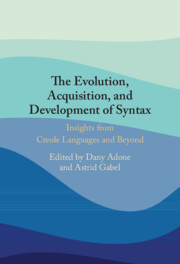Book contents
- The Evolution, Acquisition, and Development of Syntax
- The Evolution, Acquisition, and Development of Syntax
- Copyright page
- Contents
- Figures
- Tables
- Contributors
- Acknowledgments
- Abbreviations
- 1 Introduction
- Part I The Evolution of Syntax
- 2 From the Protolanguage Spectrum to the Underlying Bases of Language
- 3 From Protolanguage to Deuterolanguage: The Importance of Compounds
- 4 The SOV Mystery and Language Evolution
- 5 Broken Windows: Creoles, Pidgins, and Language Evolution
- 6 Roots of Syntax: Anaphora and Negation in Creoles
- Part II The Acquisition of Syntax
- Part III The Development of Syntax
- Index
- References
5 - Broken Windows: Creoles, Pidgins, and Language Evolution
from Part I - The Evolution of Syntax
Published online by Cambridge University Press: 19 February 2025
- The Evolution, Acquisition, and Development of Syntax
- The Evolution, Acquisition, and Development of Syntax
- Copyright page
- Contents
- Figures
- Tables
- Contributors
- Acknowledgments
- Abbreviations
- 1 Introduction
- Part I The Evolution of Syntax
- 2 From the Protolanguage Spectrum to the Underlying Bases of Language
- 3 From Protolanguage to Deuterolanguage: The Importance of Compounds
- 4 The SOV Mystery and Language Evolution
- 5 Broken Windows: Creoles, Pidgins, and Language Evolution
- 6 Roots of Syntax: Anaphora and Negation in Creoles
- Part II The Acquisition of Syntax
- Part III The Development of Syntax
- Index
- References
Summary
Roberge’s chapter presents Bickerton’s creolisation as a catastrophic single-generation process that obtains from first language acquisition in abnormal circumstances. In the ‘interesting’ cases, at least, a pidgin provides the primary linguistic data, and an innate biological program of linguistic competence shapes the result. On this view (i) the formation of these languages points directly to humankind’s biological capacity to create language should the normal generation-to-generation means of transmission be disrupted; and (ii) creoles provide the most direct window possible on the properties of the human language faculty. In his chapter Roberge chronicles the development and reception of Bickerton’s creole and pidgin windows on the origin and evolution of language in our species through their entire arc. While posterity has firmly rejected Bickerton’s creole window on early human language, Roberge argues that the pidgin window, at least, holds some heuristic potential, though a great deal of work remains to be done.
- Type
- Chapter
- Information
- The Evolution, Acquisition and Development of SyntaxInsights from Creole Languages and Beyond, pp. 74 - 95Publisher: Cambridge University PressPrint publication year: 2025

